Channel Profiles Reveal Fault Activity along the Longmen Shan, Eastern Tibetan Plateau
Abstract
1. Introduction
2. Tectonic Setting
2.1. Geology
2.2. Seismotectonic Activity along the Longmen Shan
3. Data and Methods
3.1. Data Sources
3.2. Normalized Channel Steepness (ksn)
4. Results
5. Discussion
5.1. Deformation across Faults at Various Timescales
5.2. Signal for Seismic Risk along the Longmen Shan
5.3. Implications for Tectonics and Topographic Evolution in East Tibet
6. Conclusions
Author Contributions
Funding
Data Availability Statement
Acknowledgments
Conflicts of Interest
References
- Avouac, J.P. Mountain building, erosion, and the seismic cycle in the Nepal Himalaya. Adv. Geophys. 2003, 46, 1–80. [Google Scholar] [CrossRef]
- Willett, S.D.; Brandon, M.T. On steady states in mountain belts. Geology 2002, 30, 175–178. [Google Scholar] [CrossRef]
- Kirby, E.; Whipple, K. Quantifying differential rock-uplift rates via stream profile analysis. Geology 2001, 29, 415–418. [Google Scholar] [CrossRef]
- Kirby, E.; Whipple, K.X. Expression of active tectonics in erosional landscapes. J. Struct. Geol. 2012, 44, 54–75. [Google Scholar] [CrossRef]
- Ahnert, F. Functional relationships between denudation, relief, and uplift in large, mid-latitude drainage basins. Am. J. Sci. 1970, 268, 243–263. [Google Scholar] [CrossRef]
- Montgomery, D.R.; Brandon, M.T. Topographic controls on erosion rates in tectonically active mountain ranges. Earth Planet. Sci. Lett. 2002, 201, 481–489. [Google Scholar] [CrossRef]
- Liu-Zeng, J.; Tapponnier, P.; Gaudemer, Y.; Ding, L. Quantifying landscape differences across the Tibetan plateau: Implications for topographic relief evolution. J. Geophys. Res. 2008, 113, F04018. [Google Scholar] [CrossRef]
- Bello, S.; Lavecchia, G.; Andrenacci, C.; Ercoli, M.; Cirillo, D.; Carboni, F.; Barchi, M.R.; Brozzetti, F. Complex trans-ridge normal faults controlling large earthquakes. Sci. Rep. 2022, 12, 10676. [Google Scholar] [CrossRef]
- Bello, S.; Andrenacci, C.; Cirillo, D.; Scott, C.P.; Brozzetti, F.; Arrowsmith, J.R.; Lavecchia, G.; Ao, S. High-detail fault segmentation: Deep insight into the anatomy of the 1983 Borah Peak earthquake rupture zone (Mw 6.9, Idaho, USA). Lithosphere 2022, 1, 8100224. [Google Scholar] [CrossRef]
- Johnson, K.; Nissen, E.; Saripalli, S.; Arrowsmith, J.R.; McGarey, P.; Scharer, K.; Williams, P.; Blisniuk, K. Rapid mapping of ultrafine fault zone topography with structure from motion. Geosphere 2014, 10, 969–986. [Google Scholar] [CrossRef]
- Zhang, J.; Yang, H.; Liu-Zeng, J.; Ge, Y.; Wang, W.; Yao, W.; Xu, S. Reconstructing the incision of the Lancang River (Upper Mekong) in southeastern Tibet below its prominent knickzone using fluvial terraces and transient tributary profiles. Geomorphology 2020, 376, 107551. [Google Scholar] [CrossRef]
- Goren, L.; Fox, M.; Willett, S.D. Tectonics from fluvial topography using formal linear inversion: Theory and applications to the Inyo Mountains, California. J. Geophys. Res. Earth Surf. 2014, 119, 1651–1681. [Google Scholar] [CrossRef]
- Snyder, N.P.; Whipple, K.X.; Tucker, G.E.; Merritts, D.J. Landscape response to tectonic forcing: Digital elevation model analysis of stream profiles in the Mendocino triple junction region, northern California. Geol. Soc. Am. Bull. 2000, 112, 1250–1263. [Google Scholar] [CrossRef]
- Pritchard, D.; Roberts, G.; White, N.; Richardson, C. Uplift histories from river profiles. Geophys. Res. Lett. 2009, 36, L24301. [Google Scholar] [CrossRef]
- Kirby, E.; Whipple, K.X.; Tang, W.; Chen, Z. Distribution of active rock uplift along the eastern margin of the Tibetan Plateau: Inferences from bedrock channel longitudinal profiles. J. Geophys. Res. 2003, 108, 2217. [Google Scholar] [CrossRef]
- Wobus, C.; Whipple, K.X.; Kirby, E.; Snyder, N.; Johnson, J.; Spyropolou, K.; Crosby, B.; Sheehan, D. Tectonics from topography: Procedures, promise, and pitfalls. Geol. Soc. Am. Spec. Pap. 2006, 398, 55–74. [Google Scholar]
- Nennewitz, M.; Thiede, R.C.; Bookhagen, B. Fault activity, tectonic segmentation, and deformation pattern of the western Himalaya on Ma timescales inferred from landscape morphology. Lithosphere 2018, 10, 632–640. [Google Scholar] [CrossRef]
- Baldwin, J.A.; Whipple, K.X.; Tucker, G.E. Implications of the shear stress river incision model for the timescale of postorogenic decay of topography. J. Geophys. Res. Solid Earth 2003, 108, 2158. [Google Scholar] [CrossRef]
- Aron, F.; Johnstone, S.A.; Mavrommatis, A.; Sare, R.; Maerten, F.; Loveless, J.P.; Baden, C.W.; Hilley, G.E. Mountain rivers reveal the earthquake hazard of geologic faults in Silicon Valley. Geophys. Res. Lett. 2022, 49, e2022GL099220. [Google Scholar] [CrossRef]
- Rimando, J.M.; Schoenbohm, L.M. Regional relative tectonic activity of structures in the Pampean flat slab segment of Argentina from 30 to 32°S. Geomorphology 2020, 350, 106908. [Google Scholar] [CrossRef]
- Wang, W.; Godard, V.; Liu-Zeng, J.; Zhang, J.; Li, Z.; Xu, S.; Yao, W.; Yuan, Z.; Aumaître, G.; Bourlès, D.L. Tectonic controls on surface erosion rates in the Longmen Shan, Eastern Tibet. Tectonics 2021, 40, e2020TC006445. [Google Scholar] [CrossRef]
- Godard, V.; Cattin, R.; Lavé, J. Erosional control on the dynamics of low-convergence rate continental plateau margins. Geophys. J. Int 2009, 179, 763–777. [Google Scholar] [CrossRef]
- Liu-Zeng, J.; Wen, L.; Oskin, M.; Zeng, L. Focused modern denudation of the Longmen Shan margin, eastern Tibetan Plateau. Geochem. Geophys. Geosystems 2011, 12, Q11007. [Google Scholar] [CrossRef]
- Xu, X.; Han, Z.; Yang, X.; Zhang, S.; Yu, G.; Zhou, B.; Li, F.; Ma, B.; Chen, G.; Ran, Y. Seismic Structure Map of China and Its Adjacent Areas; Seismological Press (in Chinese): Beijing, China, 2016. [Google Scholar]
- Wang, M.; Shen, Z.-K. Present-Day Crustal Deformation of Continental China Derived From GPS and Its Tectonic Implications. J. Geophys. Res. Solid Earth 2020, 125, e2019JB018774. [Google Scholar] [CrossRef]
- Jin, W.; Tang, L.; Yang, K.; Wan, G.; Lü, Z. Segmentation of the Longmen Mountains thrust belt, Western Sichuan Foreland Basin, SW China. Tectonophysics 2010, 485, 107–121. [Google Scholar] [CrossRef]
- Zhang, H.; Zhang, P.; Kirby, E.; Yin, J.; Liu, C.; Yu, G. Along-strike topographic variation of the Longmen Shan and its significance for landscape evolution along the eastern Tibetan Plateau. J. Asian Earth Sci. 2011, 40, 855–864. [Google Scholar] [CrossRef]
- Jia, D.; Li, Y.; Yan, B.; Li, Z.; Wang, M.; Chen, Z.; Zhang, Y. The Cenozoic thrusting sequence of the Longmen Shan fold-and-thrust belt, Eastern margin of the Tibetan plateau: Insights from low-temperature thermochronology. J. Asian Earth Sci. 2020, 198, 104381. [Google Scholar] [CrossRef]
- Xu, X.; Wen, X.; Yu, G.; Chen, G.; Klinger, Y.; Hubbard, J.; Shaw, J. Coseismic reverse-and oblique-slip surface faulting generated by the 2008 Mw 7.9 Wenchuan earthquake, China. Geology 2009, 37, 515–518. [Google Scholar] [CrossRef]
- Liu-Zeng, J.; Zhang, Z.; Wen, L.; Tapponnier, P.; Sun, J.; Xing, X.; Hu, G.; Xu, Q.; Zeng, L.; Ding, L. Co-seismic ruptures of the 12 May 2008,Ms 8.0 Wenchuan earthquake, Sichuan: East–west crustal shortening on oblique, parallel thrusts along the eastern edge of Tibet. Earth Planet. Sci. Lett. 2009, 286, 355–370. [Google Scholar] [CrossRef]
- Hubbard, J.; Shaw, J.H.; Klinger, Y. Structural setting of the 2008 Mw 7.9 Wenchuan, China, earthquake. Bull. Seismol. Soc. Am. 2010, 100, 2713–2735. [Google Scholar] [CrossRef]
- Lu, R.; He, D.; John, S.; Ma, Y.; Liu, B.; Chen, Y. Along-strike variation of the frontal zone structural geometry of the Central Longmen Shan thrust belt revealed by seismic reflection profiles. Tectonophysics 2012, 580, 178–191. [Google Scholar] [CrossRef]
- Gao, M.; Zeilinger, G.; Xu, X.; Tan, X.; Wang, Q.; Hao, M. Active tectonics evaluation from geomorphic indices for the central and the southern Longmenshan range on the Eastern Tibetan Plateau, China. Tectonics 2016, 35, 1812–1826. [Google Scholar] [CrossRef]
- Hubbard, J.; Shaw, J.H. Uplift of the Longmen Shan and Tibetan plateau, and the 2008 Wenchuan (M = 7.9) earthquake. Nature 2009, 458, 194–197. [Google Scholar] [CrossRef] [PubMed]
- Burchfiel, B.; Zhiliang, C.; Yupinc, L.; Royden, L. Tectonics of the Longmen Shan and adjacent regions, central China. Int. Geol. Rev. 1995, 37, 661–735. [Google Scholar] [CrossRef]
- Deng, Q.; Chen, S.; Zhao, X. Tectonics, seismicity and dynamics of Longmenshan Mountains and its adjacent regions. Seismol. Geol. 1994, 16, 389–403. [Google Scholar]
- Burchfiel, B.; Royden, L.; van der Hilst, R.; Hager, B.; Chen, Z.; King, R.; Li, C.; Lü, J.; Yao, H.; Kirby, E. A geological and geophysical context for the Wenchuan earthquake of 12 May 2008, Sichuan, People’s Republic of China. GSA Today 2008, 18, 4–11. [Google Scholar] [CrossRef]
- Arne, D.; Worley, B.; Wilson, C.; Chen, S.F.; Foster, D.; Luo, Z.L.; Liu, S.G.; Dirks, P. Differential exhumation in response to episodic thrusting along the eastern margin of the Tibetan Plateau. Tectonophysics 1997, 280, 239–256. [Google Scholar] [CrossRef]
- Kirby, E.; Reiners, P.W.; Krol, M.A.; Whipple, K.X.; Hodges, K.V.; Farley, K.A.; Tang, W.; Chen, Z. Late Cenozoic evolution of the eastern margin of the Tibetan Plateau: Inferences from 40Ar/39Ar and (U-Th)/He thermochronology. Tectonics 2002, 21, 1. [Google Scholar] [CrossRef]
- Godard, V.; Pik, R.; Lavé, J.; Cattin, R.; Tibari, B.; De Sigoyer, J.; Pubellier, M.; Zhu, J. Late Cenozoic evolution of the central Longmen Shan, eastern Tibet: Insight from (U-Th)/He thermochronometry. Tectonics 2009, 28, TC5009. [Google Scholar] [CrossRef]
- Cook, K.; Royden, L.; Burchfiel, B.; Lee, Y.-H.; Tan, X. Constraints on Cenozoic tectonics in the southwestern Longmen Shan from low-temperature thermochronology. Lithosphere 2013, 5, 393–406. [Google Scholar] [CrossRef]
- Wang, E.; Kirby, E.; Furlong, K.P.; van Soest, M.; Xu, G.; Shi, X.; Kamp, P.J.; Hodges, K. Two-phase growth of high topography in eastern Tibet during the Cenozoic. Nat. Geosci. 2012, 5, 640–645. [Google Scholar] [CrossRef]
- Furlong, K.P.; Kirby, E. Exploiting Thermochronology to Quantify Exhumation Histories and Patterns of Uplift Along the Margins of Tibet. Front. Earth Sci. 2021, 9, 469. [Google Scholar] [CrossRef]
- Ran, Y.; Chen, L.; Chen, J.; Wang, H.; Chen, G.; Yin, J.; Shi, X.; Li, C.; Xu, X. Paleoseismic evidence and repeat time of large earthquakes at three sites along the Longmenshan fault zone. Tectonophysics 2010, 491, 141–153. [Google Scholar] [CrossRef]
- Xu, X.; Wen, X.; Han, Z. Lushan Ms 7.0 earthquake: A blind reserve-fault event. Chin. Sci. Bull. 2013, 58, 3437–3443. [Google Scholar] [CrossRef]
- Yang, X.; Jiang, P.; Song, F.; Liang, X.; Chen, X.; Deng, Z. The evidence of the south Longmenshan fault zones cutting late Quaternary stratum. Seismol. Geol. 1999, 21, 341–345. (In Chinese) [Google Scholar]
- Wang, H.; Chen, L.; Ran, Y.; Lei, S.; Li, X. Paleoseismic investigation of the seismic gap between the seismogenic structures of the 2008 Wenchuan and 2013 Lushan earthquakes along the Longmen Shan fault zone at the eastern margin of the Tibetan Plateau. Lithosphere 2015, 7, 14–20. [Google Scholar] [CrossRef]
- Dong, S.-p.; Han, Z.-j.; An, Y.-f. Paleoseismological events in the “seismic gap” between the 2008 Wenchuan and the 2013 Lushan earthquakes and implications for future seismic potential. J. Asian Earth Sci. 2017, 135, 1–15. [Google Scholar] [CrossRef]
- Wang, X. Analysis of the late Quaternary activity along the Maowen-Wenchuan fault-middle part of the Back-range fault at the Longmenshan fault zone. Master’s Thesis, Institute of Geology, Affiliated to China Earthquake Administration, Beijing, China, 2016. (In Chinese with English abstract). [Google Scholar]
- Ma, B.-Q.; Su, G.; Hou, Z.-H.; Shu, S.-b. Late Quaternary slip rate in the central part of the Longmenshan fault zone from terrace deformation along the Minjiang River. Seismol. Geol. 2005, 27, 234–242. (In Chinese) [Google Scholar]
- Densmore, A.L.; Ellis, M.A.; Li, Y.; Zhou, R.; Hancock, G.S.; Richardson, N. Active tectonics of the Beichuan and Pengguan faults at the eastern margin of the Tibetan Plateau. Tectonics 2007, 26, TC4005. [Google Scholar] [CrossRef]
- Zhou, R.J.; Li, Y.; DENSMORE, A.L.; ELLIS, M.A.; He, Y.L.; Li, Y.Z.; Li, Y.G. Active Tectonics of the Longmen Shan Region on the Eastern Margin of the Tibetan Plateau. Acta Geol. Sin. (Engl. Ed.) 2007, 81, 593–604. [Google Scholar]
- Ran, Y.; Chen, W.; Xu, X.; Chen, L.; Wang, H.; Li, Y. Late Quaternary paleoseismic behavior and rupture segmentation of the Yingxiu-Beichuan fault along the Longmen Shan fault zone, China. Tectonics 2014, 33, 2218–2232. [Google Scholar] [CrossRef]
- Chen, S.F.; Wilson, C.J.L.; Deng, Q.D.; Zhao, X.L.; Luo, Z.L. Active faulting and block movement associated with large earthquakes in the Min Shan and Longmen Mountains, northeastern Tibetan Plateau. J. Geophys. Res. 1994, 99, 24025–24038. [Google Scholar] [CrossRef]
- Sun, H.; He, H.; Ikeda, Y.; Kano, K.i.; Shi, F.; Gao, W.; Echigo, T.; Okada, S. Holocene paleoearthquake history on the Qingchuan fault in the northeastern segment of the Longmenshan Thrust Zone and its implications. Tectonophysics 2015, 660, 92–106. [Google Scholar] [CrossRef]
- Liang, M.; Ran, Y.; Wang, H.; Li, Y.; Gao, S. A Possible Tectonic Response Between the Qingchuan Fault and the Beichuan-Yingxiu Fault of the Longmen Shan Fault Zone? Evidence From Geologic Observations by Paleoseismic Trenching and Radiocarbon Dating. Tectonics 2018, 37, 4086–4096. [Google Scholar] [CrossRef]
- Chen, G.; Ji, F.; Zhou, R.; Xu, J.; Zhou, B.; Li, X.; Ye, Y. Primary Research of Activity Segmentation of Longmenshan Fault Zone Since Late-Quaternary. Seismol. Geol. 2007, 29, 657–673. (In Chinese) [Google Scholar]
- Zhang, P.-Z. A review on active tectonics and deep crustal processes of the Western Sichuan region, eastern margin of the Tibetan Plateau. Tectonophysics 2013, 584, 7–22. [Google Scholar] [CrossRef]
- Boulton, S.J.; Stokes, M. Which DEM is best for analyzing fluvial landscape development in mountainous terrains? Geomorphology 2018, 310, 168–187. [Google Scholar] [CrossRef]
- Fick, S.E.; Hijmans, R.J. WorldClim 2: New 1-km spatial resolution climate surfaces for global land areas. Int. J. Climatol. 2017, 37, 4302–4315. [Google Scholar] [CrossRef]
- Flint, J.J. Stream gradient as a function of order, magnitude, and discharge. Water Resour. Res. 1974, 10, 969–973. [Google Scholar] [CrossRef]
- Whipple, K.X.; Tucker, G.E. Dynamics of the stream-power river incision model: Implications for height limits of mountain ranges, landscape response timescales, and research needs. J. Geophys. Res. Solid Earth 1999, 104, 17661–17674. [Google Scholar] [CrossRef]
- Royden, L.; Clark, M.; Whipple, K. Evolution of river elevation profiles by bedrock incision: Analytical solutions for transient river profiles related to changing uplift and precipitation rates. Eos Trans. AGU 2000, 81, 48. [Google Scholar]
- Perron, J.T.; Royden, L. An integral approach to bedrock river profile analysis. Earth Surf. Process. Landf. 2013, 38, 570–576. [Google Scholar] [CrossRef]
- Leonard, J.S.; Whipple, K.X.; Heimsath, A.M. Isolating climatic, tectonic, and lithologic controls on mountain landscape evolution. Sci. Adv. 2023, 9, eadd8915. [Google Scholar] [CrossRef] [PubMed]
- Adams, B.; Whipple, K.; Forte, A.; Heimsath, A.; Hodges, K. Climate controls on erosion in tectonically active landscapes. Sci. Adv. 2020, 6, eaaz3166. [Google Scholar] [CrossRef]
- Gallen, S.F.; Wegmann, K.W. River profile response to normal fault growth and linkage: An example from the Hellenic forearc of south-central Crete, Greece. Earth Surf. Dyn. 2017, 5, 161. [Google Scholar] [CrossRef]
- Schwanghart, W.; Scherler, D. Short Communication: TopoToolbox 2—MATLAB-based software for topographic analysis and modeling in Earth surface sciences. Earth Surf. Dyn. 2014, 2, 1–7. [Google Scholar] [CrossRef]
- Ansberque, C.; Godard, V.; Olivetti, V.; Bellier, O.; Sigoyer, J.; Bernet, M.; Stübner, K.; Tan, X.; Xu, X.; Ehlers, T.A. Differential Exhumation Across the Longriba Fault System: Implications for the Eastern Tibetan Plateau. Tectonics 2018, 37, 663–679. [Google Scholar] [CrossRef]
- Jolivet, M.; Roger, F.; Xu, Z.; Paquette, J.-L.; Cao, H. Mesozoic–Cenozoic evolution of the Danba dome (Songpan Garzê, East Tibet) as inferred from LA-ICPMS U–Pb and fission-track data. J. Asian Earth Sci. 2015, 102, 180–204. [Google Scholar] [CrossRef]
- Richardson, N.J.; Densmore, A.L.; Seward, D.; Fowler, A.; Wipf, M.; Ellis, M.A.; Yong, L.; Zhang, Y. Extraordinary denudation in the Sichuan Basin: Insights from low-temperature thermochronology adjacent to the eastern margin of the Tibetan Plateau. J. Geophys. Res.-Solid Earth 2008, 113, B04409. [Google Scholar] [CrossRef]
- Xu, G.; Kamp, P.J.J. Tectonics and denudation adjacent to the Xianshuihe Fault, eastern Tibetan Plateau: Constraints from fission track thermochronology. J. Geophys. Res. Atmos. 2000, 105, 19231–19252. [Google Scholar] [CrossRef]
- Wilson, C.J.; Fowler, A.P. Denudational response to surface uplift in east Tibet: Evidence from apatite fission-track thermochronology. Geol. Soc. Am. Bull. 2011, 123, 1966–1987. [Google Scholar] [CrossRef]
- Tan, X.-B.; Lee, Y.-H.; Chen, W.-Y.; Cook, K.L.; Xu, X.-W. Exhumation history and faulting activity of the southern segment of the Longmen Shan, eastern Tibet. J. Asian Earth Sci. 2014, 81, 91–104. [Google Scholar] [CrossRef]
- Tan, X.-B.; Lee, Y.-H.; Xu, X.-W.; Cook, K.L. Cenozoic exhumation of the Danba antiform, eastern Tibet: Evidence from low-temperature thermochronology. Lithosphere 2017, 9, 534–544. [Google Scholar] [CrossRef]
- Tan, X.-B.; Xu, X.-W.; Lee, Y.-H.; Lu, R.-Q.; LIu, Y.; Xu, C.; Li, K.; Yu, G.-H.; Kang, W.-J. Late Cenozoic thrusting of major faults along the central segment of Longmen Shan, eastern Tibet: Evidence from low-temperature thermochronology. Tectonophysics 2017, 712–713, 145–155. [Google Scholar] [CrossRef]
- Tan, X.; Liu, Y.; Lee, Y.-H.; Lu, R.; Xu, X.; Suppe, J.; Shi, F.; Xu, C. Parallelism between the maximum exhumation belt and the Moho ramp along the eastern Tibetan Plateau margin: Coincidence or consequence? Earth Planet. Sci. Lett. 2019, 507, 73–84. [Google Scholar] [CrossRef]
- Tian, Y.; Kohn, B.P.; Gleadow, A.J.W.; Hu, S. Constructing the Longmen Shan eastern Tibetan Plateau margin: Insights from low-temperature thermochronology. Tectonics 2013, 32, 576–592. [Google Scholar] [CrossRef]
- Tian, Y.; Li, R.; Tang, Y.; Xu, X.; Wang, Y.; Zhang, P. Thermochronological Constraints on the Late Cenozoic Morphotectonic Evolution of the Min Shan, the Eastern Margin of the Tibetan Plateau. Tectonics 2018, 37, 1733–1749. [Google Scholar] [CrossRef]
- Tian, Y.; Liu, Y.; Li, R.; Sun, X.; Zhang, Z.; Carter, A.; Vermeesch, P. Thermochronological constraints on Eocene deformation regime in the Long-Men Shan: Implications for the eastward growth of the Tibetan Plateau. Glob. Planet. Chang. 2022, 217, 103930. [Google Scholar] [CrossRef]
- Yang, Z.; Shen, C.; Ratschbacher, L.; Enkelmann, E.; Jonckheere, R.; Wauschkuhn, B.; Dong, Y. Sichuan Basin and beyond: Eastward foreland growth of the Tibetan Plateau from an integration of Late Cretaceous-Cenozoic fission track and (U-Th)/He ages of the eastern Tibetan Plateau, Qinling, and Daba Shan. J. Geophys. Res. Solid Earth 2017, 122, 4712–4740. [Google Scholar] [CrossRef]
- Shen, X.; Tian, Y.; Zhang, G.; Zhang, S.; Carter, A.; Kohn, B.; Vermeesch, P.; Liu, R.; Li, W. Late Miocene hinterland crustal shortening in the Longmen Shan thrust belt, the eastern margin of the Tibetan Plateau. J. Geophys. Res. Solid Earth 2019, 124, 11972–11991. [Google Scholar] [CrossRef]
- van der Beek, P.; Schildgen, T.F. Short Communication: age2exhume—A Matlab/Python script to calculate steady-state vertical exhumation rates from thermochronologic ages and application to the Himalaya. Geochronology 2023, 5, 35–49. [Google Scholar] [CrossRef]
- Willett, S.D.; Brandon, M.T. Some analytical methods for converting thermochronometric age to erosion rate. Geochem. Geophys. Geosystems 2013, 14, 209–222. [Google Scholar] [CrossRef]
- Jia, D.; Li, Y.; Lin, A.; Wang, M.; Chen, W.; Wu, X.; Ren, Z.; Zhao, Y.; Luo, L. Structural model of 2008 Mw7.9 Wenchuan earthquake in the rejuvenated Longmen Shan thrust belt, China. Tectonophysics 2010, 491, 174–184. [Google Scholar] [CrossRef]
- Li, Y.; Lu, R.; He, D.; Wang, X.; Liu, Y.; Xu, X.; Tan, X.; Cai, M. Transformation of coseismic faults in the northern Longmenshan tectonic belt, eastern Tibetan Plateau: Implications for potential earthquakes and seismic risks. J. Asian Earth Sci. 2019, 177, 66–75. [Google Scholar] [CrossRef]
- Lu, R.; Xu, X.; He, D.; John, S.; Liu, B.; Wang, F.; Tan, X.; Li, Y. Seismotectonics of the 2013 Lushan Mw 6.7 earthquake: Inversion tectonics in the eastern margin of the Tibetan Plateau. Geophys. Res. Lett. 2017, 44, 8236–8243. [Google Scholar] [CrossRef]
- Chen, L.C.; Ran, Y.K.; Wang, H.; Li, Y.B.; Ma, X.Q. The Lushan M S 7.0 earthquake and activity of the southern segment of the Longmenshan fault zone. Sci. Bull. 2013, 58, 3475–3482. [Google Scholar] [CrossRef]
- Li, C.Y.; Song, F.M.; Ran, Y.K. Late Quaternary activity and age constraint of the northern Longmen Shan Fault zone. Seismol. Geol. 2004, 26, 248–258. (In Chinese) [Google Scholar]
- Zhang, P.Z.; Shen, Z.; Wang, M.; Gan, W.; Bürgmann, R.; Molnar, P.; Wang, Q.; Niu, Z.; Sun, J.; Wu, J. Continuous deformation of the Tibetan Plateau from global positioning system data. Geology 2004, 32, 809–812. [Google Scholar] [CrossRef]
- Gan, W.; Zhang, P.; Shen, Z.-K.; Niu, Z.; Wang, M.; Wan, Y.; Zhou, D.; Cheng, J. Present-day crustal motion within the Tibetan Plateau inferred from GPS measurements. J. Geophys. Res. 2007, 112, B08416. [Google Scholar] [CrossRef]
- Zhang, P.-Z. Beware of slowly slipping faults. Nat. Geosci. 2013, 6, 323–324. [Google Scholar] [CrossRef]
- Liu, C.; Zhu, B.; Shi, Y. Do the Two Seismic Gaps in the Southwestern Section of the Longmen Shan Fault Present the Same Seismic Hazard? J. Geophys. Res. Solid Earth 2020, 125, e2019JB018160. [Google Scholar] [CrossRef]
- Chen, L.; Wang, H.; Ran, Y.; Lei, S.; Li, X.; Wu, F.; Ma, X.; Liu, C.; Han, F. The 2013 Lushan M S 7.0 earthquake: Varied seismogenic structure from the 2008 Wenchuan earthquake. Seismol. Res. Lett. 2014, 85, 34–39. [Google Scholar]
- Wang, Z.; Su, J.; Liu, C.; Cai, X. New insights into the generation of the 2013 Lushan earthquake (Ms 7.0), China. J. Geophys. Res. Solid Earth 2015, 120, 3507–3526. [Google Scholar] [CrossRef]
- Lei, J.; Zhang, G.; Xie, F. The 20 April 2013 Lushan, Sichuan, mainshock, and its aftershock sequence: Tectonic implications. Earthq. Sci. 2014, 27, 15–25. [Google Scholar] [CrossRef]
- Jones, L.M.; Han, W.; Hauksson, E.; Jin, A.; Zhang, Y.; Luo, Z. Focal mechanisms and aftershock locations of the Songpan earthquakes of August 1976 in Sichuan, China. J. Geophys. Res. Solid Earth 1984, 89, 7697–7707. [Google Scholar] [CrossRef]
- Xu, X.-W.; Chen, G.-H.; Wang, Q.-X.; Chen, L.-C.; Ren, Z.-K.; Xu, C.; Wei, Z.-Y.; Lu, R.-Q.; Tan, X.-B.; Dong, S.-P. Discussion on seismogenic structure of Jiuzhaigou earthquake and its implication for current strain state in the southeastern Qinghai-Tibet Plateau. Chin. J. Geophys. 2017, 60, 4018–4026. [Google Scholar]
- Airaghi, L.; de Sigoyer, J.; Guillot, S.; Robert, A.; Warren, C.J.; Deldicque, D. The Mesozoic Along-Strike Tectonometamorphic Segmentation of Longmen Shan (Eastern Tibetan Plateau). Tectonics 2018, 37, 4655–4678. [Google Scholar] [CrossRef]
- Clark, M.K.; Bush, J.W.; Royden, L.H. Dynamic topography produced by lower crustal flow against rheological strength heterogeneities bordering the Tibetan Plateau. Geophys. J. Int. 2005, 162, 575–590. [Google Scholar] [CrossRef]
- Clark, M.K.; Royden, L.H. Topographic ooze: Building the eastern margin of Tibet by lower crustal flow. Geology 2000, 28, 703–706. [Google Scholar] [CrossRef]
- Cook, K.L.; Royden, L.H. The role of crustal strength variations in shaping orogenic plateaus, with application to Tibet. J. Geophys. Res. Solid Earth 2008, 113, B08407. [Google Scholar] [CrossRef]
- Royden, L.H.; Burchfiel, B.C.; King, R.W.; Wang, E.; Chen, Z.; Shen, F.; Liu, Y. Surface deformation and lower crustal flow in eastern Tibet. Science 1997, 276, 788–790. [Google Scholar] [CrossRef] [PubMed]
- Ouimet, W.B. Landslides associated with the May 12, 2008 Wenchuan earthquake: Implications for the erosion and tectonic evolution of the Longmen Shan. Tectonophysics 2010, 491, 244–252. [Google Scholar] [CrossRef]
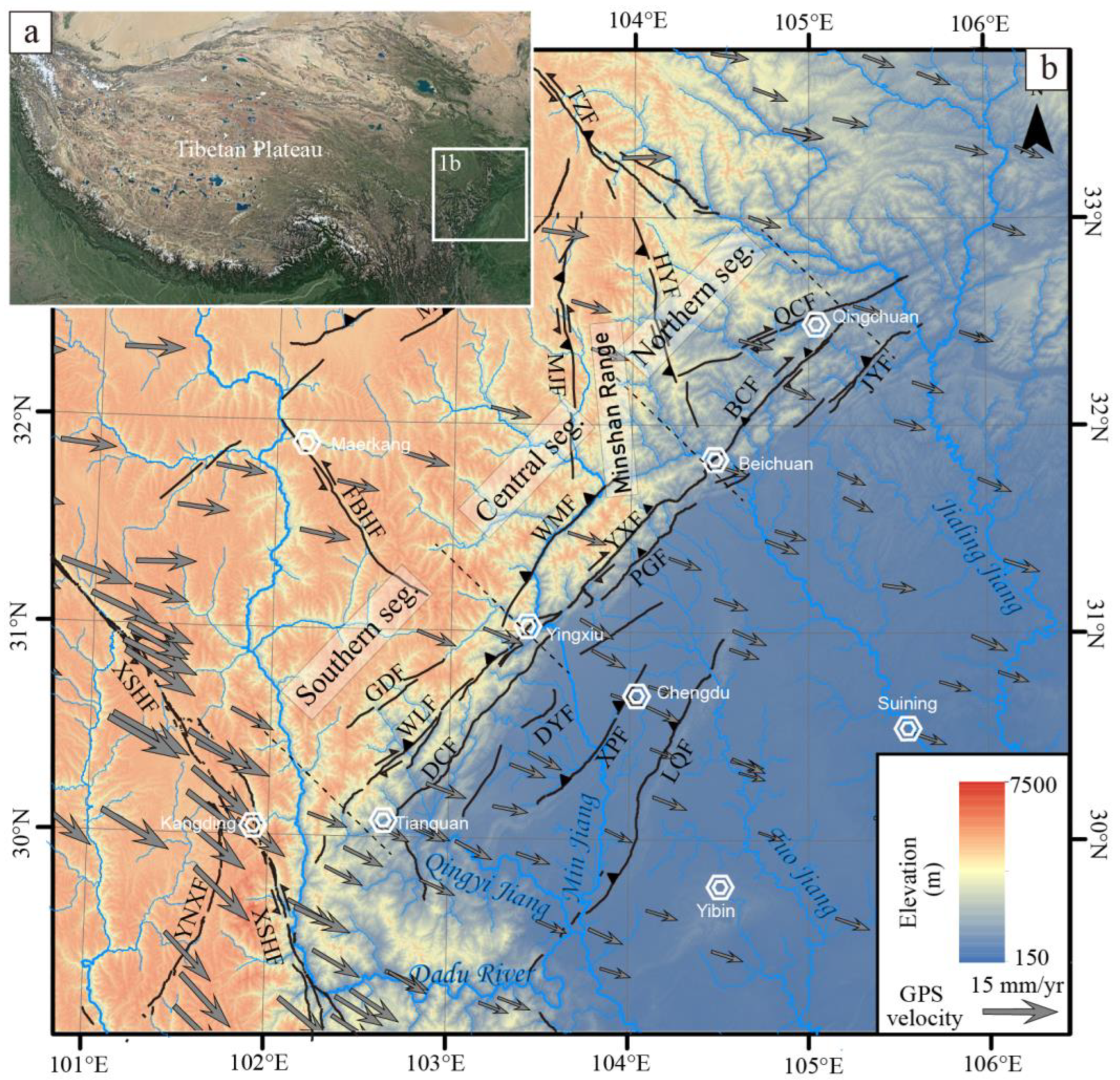

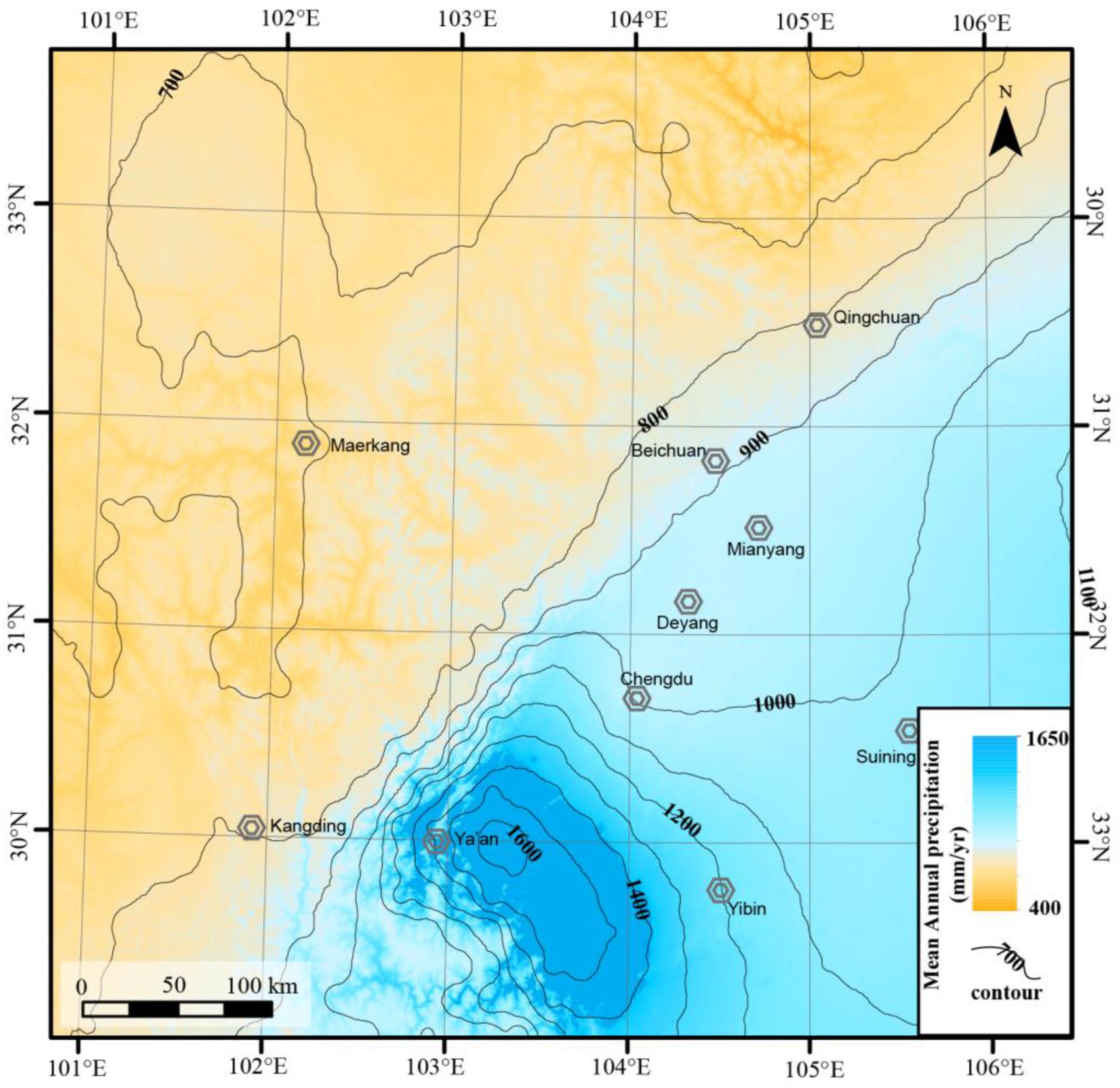
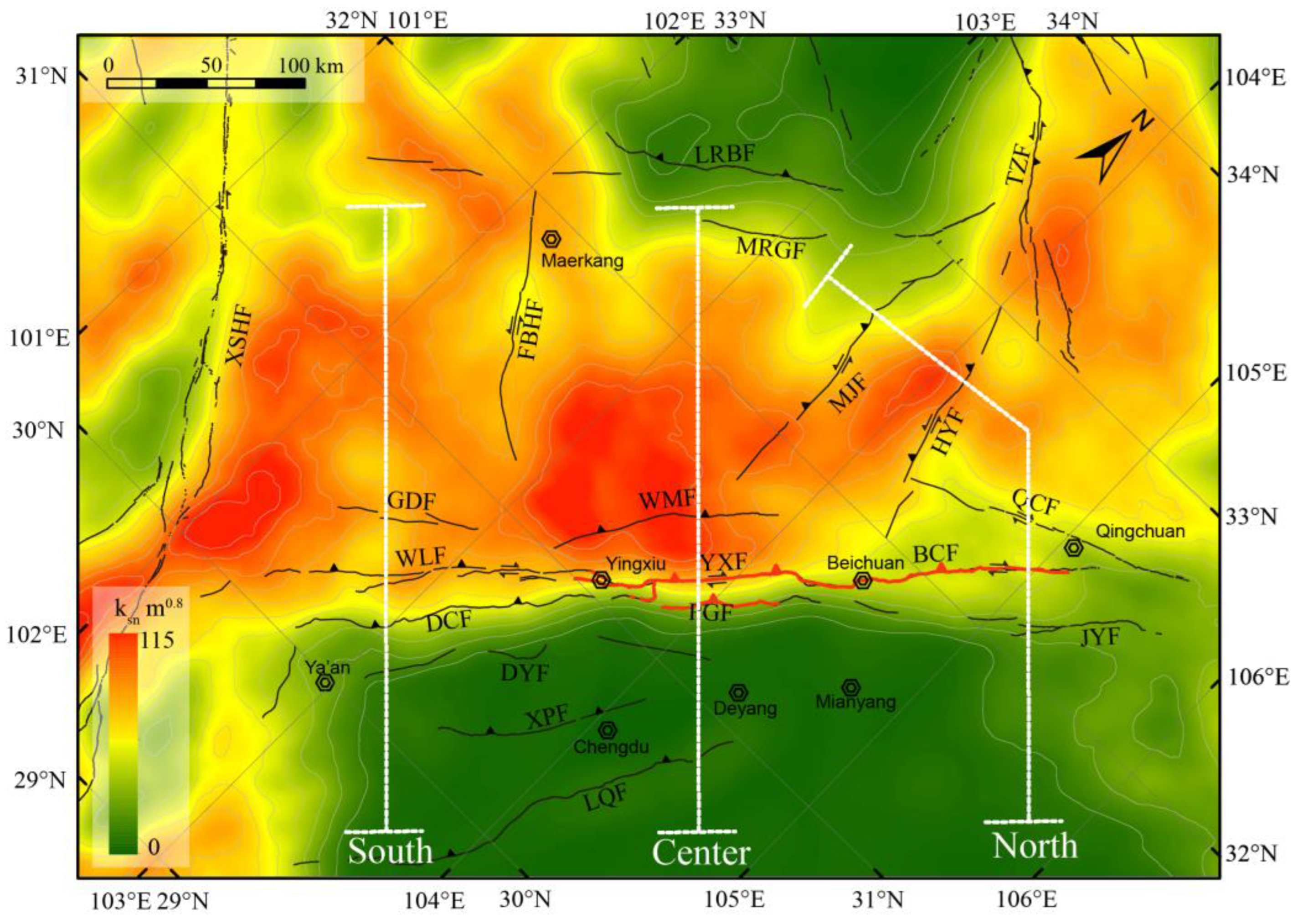
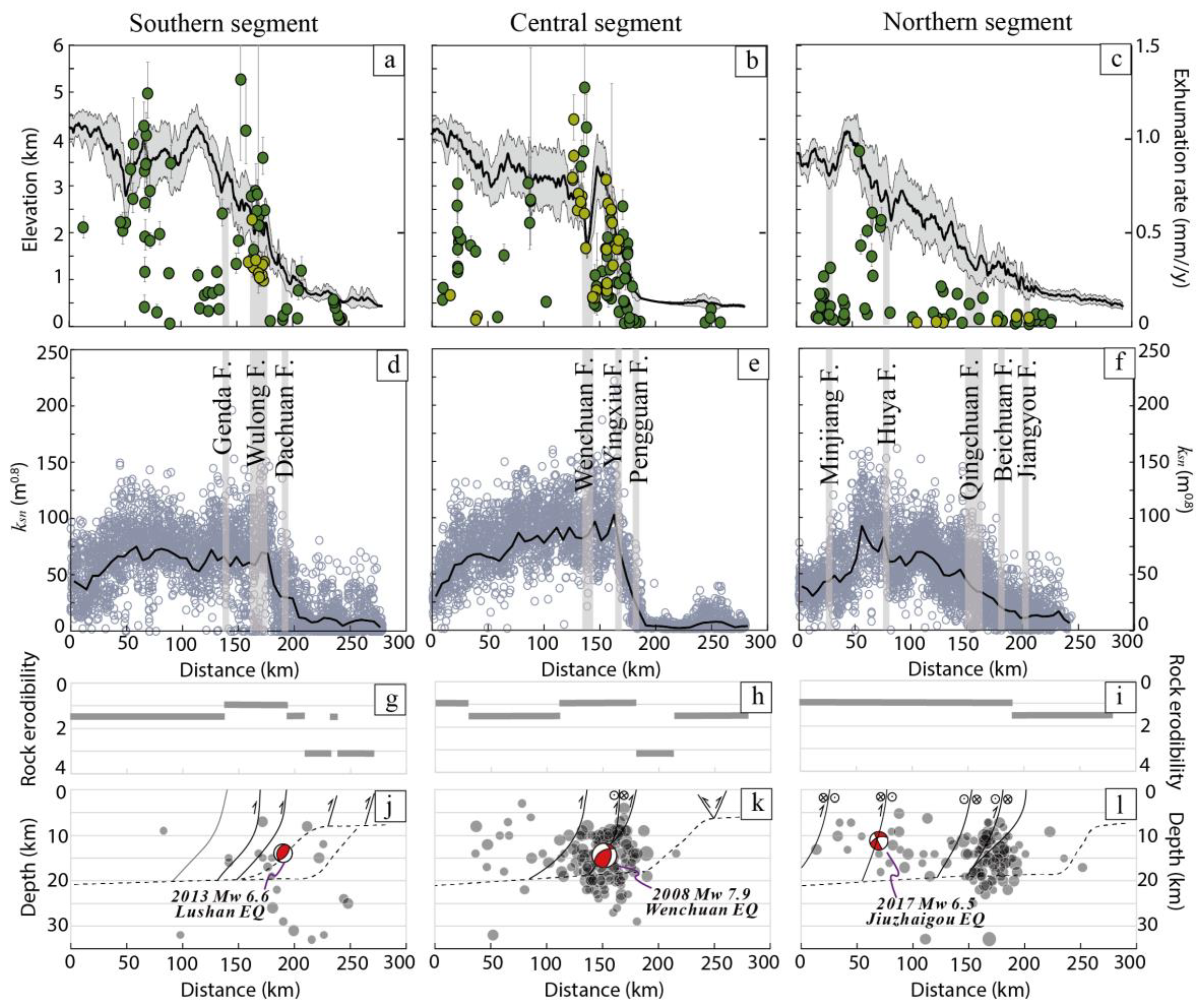
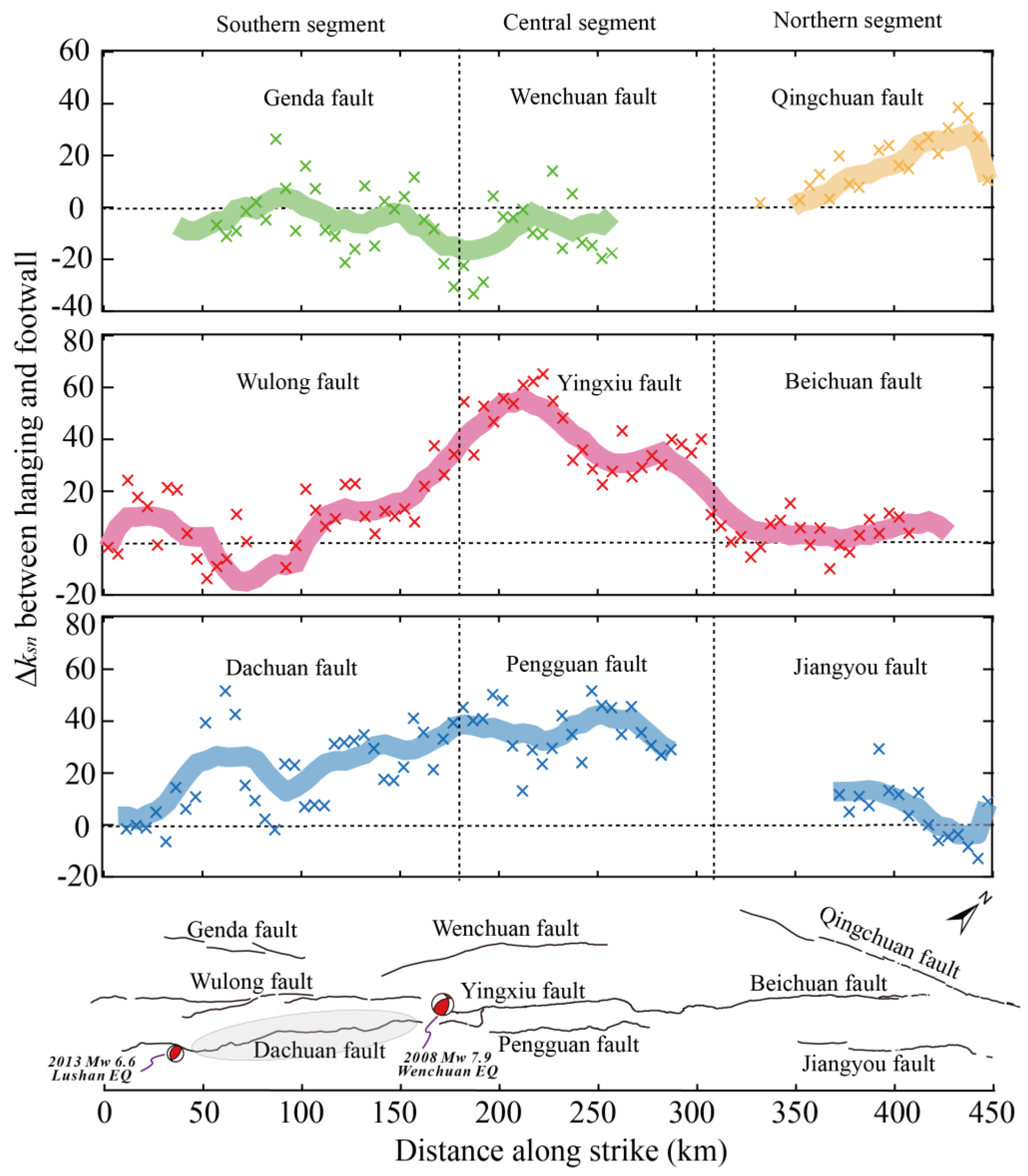
Disclaimer/Publisher’s Note: The statements, opinions and data contained in all publications are solely those of the individual author(s) and contributor(s) and not of MDPI and/or the editor(s). MDPI and/or the editor(s) disclaim responsibility for any injury to people or property resulting from any ideas, methods, instructions or products referred to in the content. |
© 2023 by the authors. Licensee MDPI, Basel, Switzerland. This article is an open access article distributed under the terms and conditions of the Creative Commons Attribution (CC BY) license (https://creativecommons.org/licenses/by/4.0/).
Share and Cite
Wang, W.; Shao, Y.; Zhang, J.; Wang, W.; Lu, R. Channel Profiles Reveal Fault Activity along the Longmen Shan, Eastern Tibetan Plateau. Remote Sens. 2023, 15, 4721. https://doi.org/10.3390/rs15194721
Wang W, Shao Y, Zhang J, Wang W, Lu R. Channel Profiles Reveal Fault Activity along the Longmen Shan, Eastern Tibetan Plateau. Remote Sensing. 2023; 15(19):4721. https://doi.org/10.3390/rs15194721
Chicago/Turabian StyleWang, Wei, Yanxiu Shao, Jinyu Zhang, Wenxin Wang, and Renqi Lu. 2023. "Channel Profiles Reveal Fault Activity along the Longmen Shan, Eastern Tibetan Plateau" Remote Sensing 15, no. 19: 4721. https://doi.org/10.3390/rs15194721
APA StyleWang, W., Shao, Y., Zhang, J., Wang, W., & Lu, R. (2023). Channel Profiles Reveal Fault Activity along the Longmen Shan, Eastern Tibetan Plateau. Remote Sensing, 15(19), 4721. https://doi.org/10.3390/rs15194721





